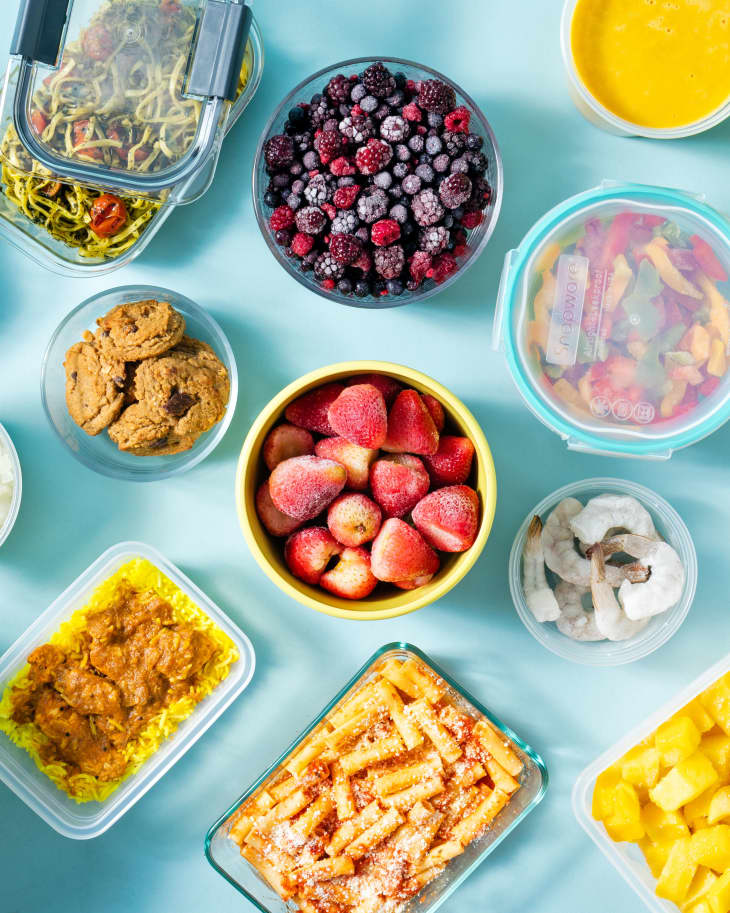The $4 Pro Chef Hack That’ll Help Organize Your *Entire* Kitchen
I recently went to help a friend just after she had her first baby, and I came home with all kinds of ideas from her beautiful, thoughtfully curated, meticulous home. Although she currently works as a paralegal, she’s also a professional chef and her kitchen displays not only her love of cooking, but also everything she learned in culinary school — and I’m brimming with inspiration.
I was so inspired that I brought some of her ingenious kitchen habits into my own daily life at home. One of the most useful storage hacks I picked up, I found directly in her fridge and freezer.
Part of caring for my newly postpartum friend was preparing nutritious food for her, so I quickly became well-acquainted with her food storage. I noticed a neatly stacked stash of homemade pasta sauce stored in repurposed pesto containers (similar to these small deli containers) in her freezer. Even though the containers still had their original labels on them, it was clear what their new contents were because of the bright blue painter’s tape that had been used to label each and every one of them.
I noticed this blue painter’s tape labeling technique all over her kitchen, actually — for leftovers in the fridge as well as freezer contents and dry goods stored in cabinets or the pantry, all with the name of the contents and the date they were packaged (or repackaged). Working in professional kitchens, she had picked up the habit of using blue painter’s tape as the cornerstone for total home organization. I figured if a pro chef uses this strategy, it must be good. And as I adopted the habit in my own kitchen, I saw for myself how useful painter’s tape is in the kitchen.
While some chefs have specific and strict rules for how they use painter’s tape labels (for instance, some use only certain colors, insist that the tape be cut straight with scissors rather than torn, or require a particular width), there are overarching benefits of painter’s tape that make it universally appealing to pro and home chefs alike.
It’s highly visible.
As I experienced at my friend’s house when I first encountered the tip in action, the blue color stands out, even when it’s placed over other eye-catching packaging or labels. My eye was instantly drawn to the blue tape and what was written on it far more than it’s drawn to the labels I print with my label maker. Really any bold and contrasting color can be used to stand out, if you find another tape color you prefer.
It sticks, but not too much.
Painter’s tape offers just the right amount of adhesion. It sticks to surfaces strongly enough that you don’t have to worry about it falling off, even in the freezer. But when it comes time to take it off, it doesn’t leave any residue behind like masking tape can. Plus, if it doesn’t come off completely — which happens with masking tape — it makes for a messy situation when it comes time to clean the container, and especially if you want to relabel it with something new. Painter’s tape, on the other hand, is where it’s supposed to be until it’s taken off, and then leaves no trace.
It’s inexpensive.
Sixty yards of ScotchBlue Original Multi-Surface Painter’s Tape comes in at just $4.49, if you don’t already have a roll lying around somewhere. That makes for a lot of labels at a much cheaper price than labels from a label maker. For this trick, you’ll also need a permanent marker, but you probably already have one (or several) of those in your junk drawer.
It’s convenient.
The best part about using blue painter’s tape to label items in your kitchen is how convenient it is. You don’t need to use a label maker or risk ruining a perfectly good container by writing directly on it. All you have to do is grab your roll of tape, write the name of the contents and the date on it with a permanent marker, and tear or cut off the piece. You can stick it on a bag, food storage container, or any kind of repurposed container — and watch yourself waste less food, and always know which option is the best one to use.
